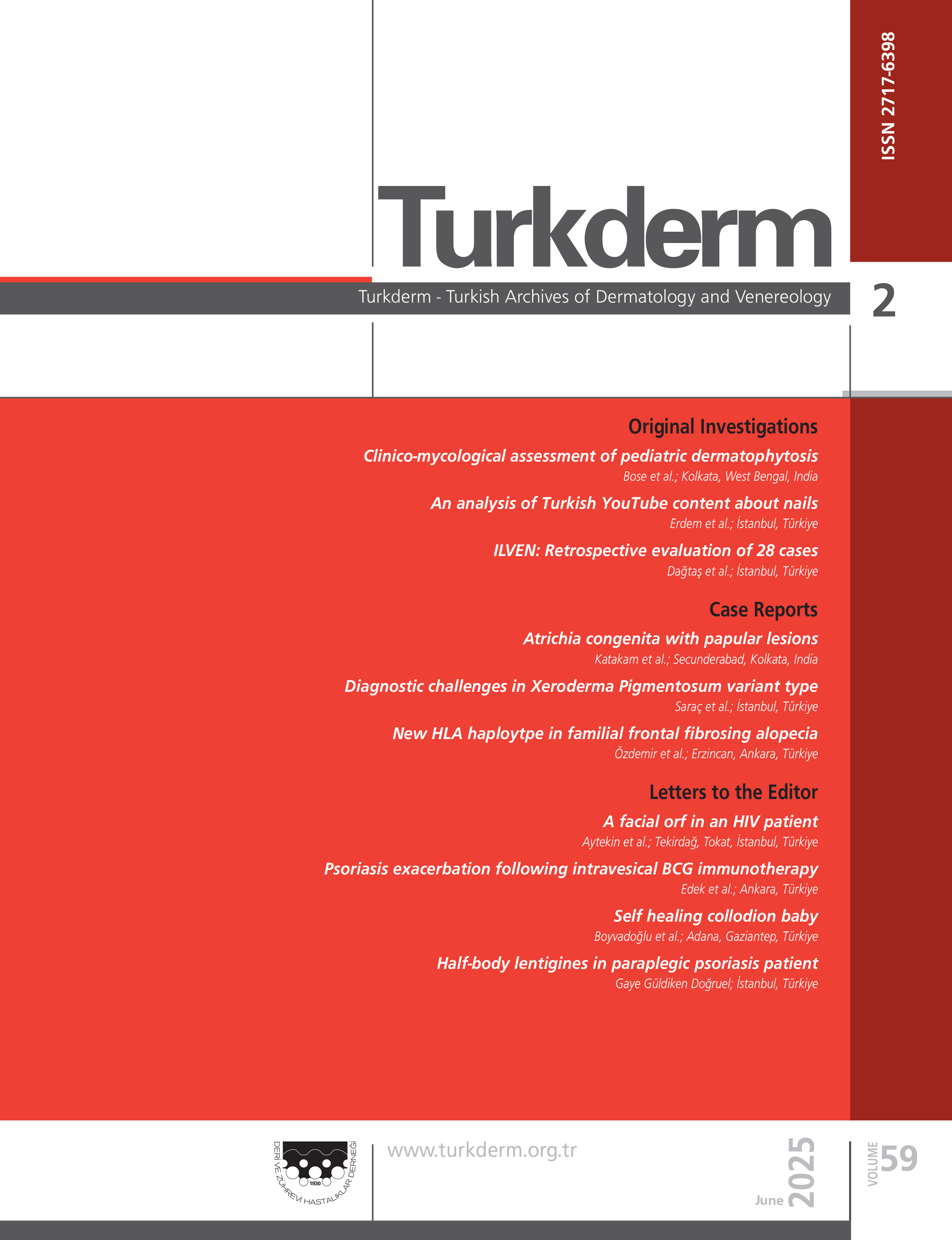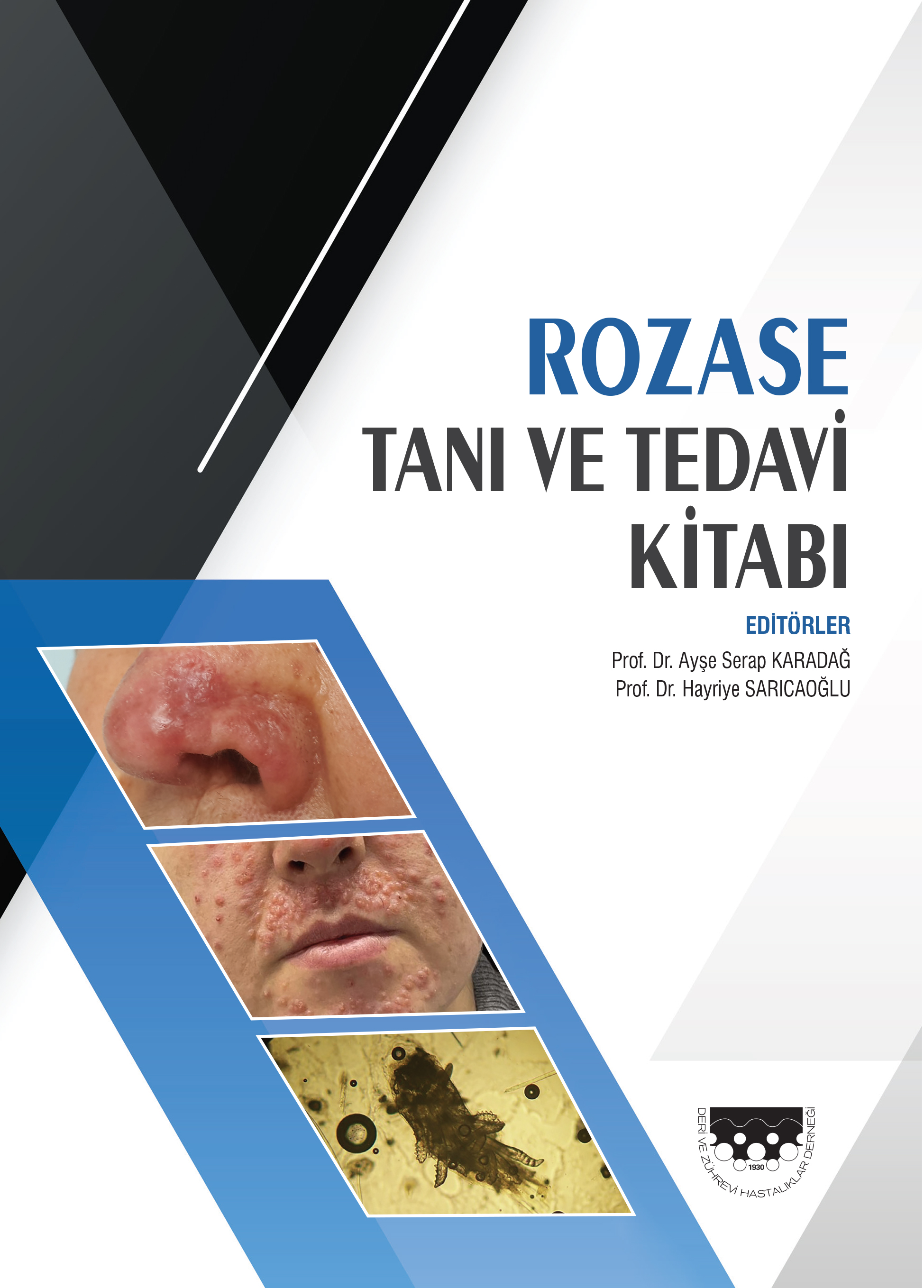Volume: 51 Issue: 3 - 2017
| REVIEW ARTICLE | |
| 1. | Comorbidities in psoriasis: The recognition of psoriasis as a systemic disease and current management Göknur Kalkan doi: 10.4274/turkderm.09476 Pages 71 - 77 Psoriasis, with a worldwide prevalence of 2-3%, is now assumed as a systemic chronic inflammatory disease accompanied by comorbidities while it was accepted as a disease limited only to the skin in the past. There are several classifications of the comorbidities which are more common in patients with moderate to severe psoriasis. Simply, comorbidities can be classified as classic, emerging, related to lifestyle, related to treatment. They can also be categorized as medical comorbidities, psychiatric/psychologic comorbidities, and behaviors contributing to medical and psychiatric comorbidities. In this review, providing early diagnosis and treatment of comorbidities, learning screening recommendations for early detection and long-term disease control and improvement in life quality by integrated, multidisciplinary approach were targeted. |
| ORIGINAL INVESTIGATION | |
| 2. | The efficacy of microphototherapy in vitiligo patients with localized lesions Neslihan Yıldırım, Gül Erkin doi: 10.4274/turkderm.37043 Pages 78 - 83 Background and Design: Vitiligo is a chronic skin disease. To reduce side effects associated with current treatment modalities, new treatment methods are required. Microphototherapy was introduced to treat vitiligo patients with a limited number of lesions (lesions affecting <10% of the body surface area). Materials and Methods: Our study has aimed to evaluate the efficacy of microphototherapy in vitiligo patients with localized lesions. In this unblinded and prospective study, patients were treated thrice weekly for at least 50 sessions using an MedLight CupCUBE Grimed® microphototherapy device which emits ultraviolet B spectrum with a starting dose of 150 mJ/cm2 for 5 seconds and with increments of 30 mj/cm2, 1 second at each session. At the end of the 50th session, 50% reduction in Vitiligo Area Scoring Index (VASI) score was accepted as the required minimum response. Results: Thirty-three lesions from 14 patients were treated. Treatment outcome was evaluated based on the VASI. Between 0th and 50th sessions, the mean VASI score in 33 lesions decreased from 2.25 to 1.79 showing 20.4% decline (p<0.05). Twenty-one of 33 lesions exhibited decrease in VASI scores at the end of the 50th session although only 11 of these 21 lesions reached the target of VASI 50% while the remaining 10 lesions did not reach the target. As a result, 11 lesions (33.3%) reached VASI 50% while the remaining 22 lesions (66.7%) did not reach the target. Conclusion: The efficacy of the MedLight CupCUBE Grimed® microphototherapy device was poor with these starting doses, durations and increments for the treatment of patients with vitiligo who had localized lesions. Trying topical therapies initially, calculating minimal erythema dose and, thus, measuring the beginning ultraviolet doses and durations as a way to decrease the number of in-hospital sessions are feasible rather than applying this technique as the first option or alone in vitiligo patients with non-segmental and localized lesions. |
| 3. | Investigation of skin infection frequency in Turkish wrestlers Ömer Kaynar, Ragıp İsmail Engin, Fikret Dağdeviren, Mikail Yılmaz, Bora Özkan, Sadık Öztürk doi: 10.4274/turkderm.81231 Pages 84 - 87 Background and Design: The aim of this study was to determine the frequency of dermatological infections among Turkish wrestlers. Materials and Methods: We included 202 wrestlers from different regions of Turkey who volunteered to participate in the study. The Athlete Biography and Dermatologic Examination Findings survey that was designed before the research was completed during dermatological examination and dermatologic findings of each athlete were evaluated. Results: During the physical examination of 202 Turkish wrestlers, 115 (57%) of participants were observed to have skin infection while no skin infection was found in 87 (43%). It has been detected that these infections were fungal, bacterial and viral in 31%, 18% and 8% of patients, respectively. The rates of infections were 25 (12%), 28 (14%), 15 (8%), 12 (6%), 12 (6%), 8 (4%), 6 (3%), 5 (2%), 2 (1%), and 2 (1%) for tinea corporis, tinea pedis, erythrasma, folliculitis, wart, onychomycosis, paronychia, herpes, impetigo, and tinea versicolor, respectively. Conclusion: In this study, it was found that Turkish wrestlers had skin infections, these infections were not as common as reported in the literature. It can be understood that early diagnosis and treatment is very important in reducing the prevalence of these infections in wrestlers. |
| 4. | Evaluation of psoriasis patients with a rheumatologic questionnaire efficiently aids in early detection of psoriatic arthritis Sibel Doğan, Nilgün Atakan, Sema Koç Yıldırım, Umut Kalyoncu, Abdülsamet Erden doi: 10.4274/turkderm.87405 Pages 88 - 91 Background and Design: Psoriatic arthritis (PsA), enthesitis and/or soft tissue swelling accompany psoriasis in 6-30% of all psoriatic patients. Early recognition of PsA is crucial since it is a serious disabling comorbidity with irreversible complications. Materials and Methods: Patients, who were admitted to the outpatient clinic of Hacettepe University Faculty of Medicine Department of Dermatology between March 2014 and 2015 with plaque psoriasis lacking any prior PsA diagnosis, were enrolled for this study. Demographic data, previous treatment history, laboratory parameters and physical examination of the patients were collected. All patients were examined by the same physician with a rheumatologic questionnaire that consists of five questions about any accompanying rheumatologic complaints. All patients who had at least one positive answer were consulted with the department of rheumatology at the same center. Results: Two hundred and twenty-three patients were included, 58% (n=129) were male and 42% (n=94) were female. The mean age of the patients was 43.46±14.31 years. The mean Psoriasis Area and Severity Index score was 12.66±9.89 standard deviation. The most common complaint detected by the questionnaire was myalgia/arthralgia at rest in 28% (n=62) of the patients. 30% (n=69) of the patients were consulted to rheumatology for a positive answer on the questionnaire and 24% (n=53) of the patients were evaluated by a rheumatologist. 51% (n=27) of the evaluated patients were diagnosed with a rheumatologic disease which were PsA in 40% (n=21), sacroiliitis in 6% (n=3), ankylosing spondylitis in 4% (n=2), and unspecified connective tissue disease in one patient. Conclusion: The improvement of dermatologists skills about suspecting, questioning and examining PsA symptoms is crucial for early diagnosis. This study concludes that a standard rheumatologic questionnaire efficiently helps dermatologists to predict PsA in psoriatic patients. |
| 5. | Blood homocysteine, folic acid, vitamin B12 and vitamin B6 levels in psoriasis patients Meltem Uslu, Neslihan Şendur, Ekin Şavk, Aslıhan Karul, Didem Kozacı, Cengiz Gökbulut, Göksun Karaman, İmran Kurt Ömürlü doi: 10.4274/turkderm.22566 Pages 92 - 97 Background and Design: Homocysteine, a sulfur-containing amino acid, is known to be related with autoimmunity-inflammation, cardiovascular disease and DNA methylation. In this case-control study, we aimed to determine plasma homocysteine, folic acid, vitamin B12 and vitamin B6 levels in patients with psoriasis. Materials and Methods: Smoking, alcohol and coffee consumption habits were recorded in adult patients with plaque-type psoriasis and age- and sex-matched controls. Height and weight measurements were performed and Psoriasis Area and Severity Index (PASI) scores were calculated. Fasting venous blood samples were collected to determine homocysteine, folic acid, vitamin B12, vitamin B6, glucose, total cholesterol, triglyceride, high density lipoprotein (HDL), erythrocyte sedimentation rate (ESR), and C-reactive protein (CRP) levels. Results: There was no significant difference between psoriasis patients (n=43) and controls (n=47) in body mass index and alcohol and coffee consumption. Smoking rate was significantly high in psoriasis patients. The median PASI score was 10.0 (8.3-12.8). Plasma homocysteine, folic acid, vitamin B12, vitamin B6, total cholesterol, triglyseride, ESR and CRP values were not significantly different between patients and the controls. HDL level was low in psoriasis patients (p=0.001). Plasma homocysteine level was higher in males than in females. There was no relationship of homocysteine levels with patients age, PASI scores, ESR, CRP values and lipids. Homocysteine levels were inversely related with folic acid and vitamin B12 (p=0.000, r=-0.436, p=0.047, r=-0.204, respectively). We did not find any relationship between homocysteine and vitamin B6 levels. Conclusion: There was no increase in plasma homocysteine levels in psoriasis patients we followed up. Homocysteine level increases in inflammatory disorders and this increase is accepted as a cardiovascular disease marker. Homocysteine homeostasis may be balanced in our patients because of the genetic background and/or nutritional habits in this population |
| CASE REPORT | |
| 6. | Non-venereal sclerosing lymphangitis of the penis: A report of two cases Ersoy Acer, Mustafa Karabıçak doi: 10.4274/turkderm.00018 Pages 98 - 100 Non-venereal sclerosing lymphangitis (NVSL) is a rare disease that develops after vigorous sexual intercourse. The disease was first described in 1923 by Hoffman. The condition is observed usually in the second or third decade of life. NVSL is characterized by a rope-like hard swelling around the coronal sulcus of the penis. It is generally painless and benign and usually resolves spontaneously. Penile Mondors disease (PMD) must be considered in differential diagnosis. The lesion is harder and adherent to the underlying skin in PMD. Patients often have pain. Venous Doppler ultrasound is normal in NVSL but increased echogenicity and incompressible veins are observed in PMD. Here, we report two cases of NVSL. Establishing the diagnosis and knowing the course of the disease by dermatologists and urologists is very important to avoid misdiagnosis, unnecessary laboratory examinations and treatment. |
| 7. | Primary umbilical endometriosis: Menstruating from the umbilicus Mustafa Taner Bostancı, Mehmet Alperen Avcı, Fatma Aksoy Khurami, Mehmet Ali Çaparlar, Ahmet Seki doi: 10.4274/turkderm.00243 Pages 101 - 103 Primary umbilical endometriosis is a rare disorder and is defined as the presence of ectopic endometrial tissue within the umbilicus. The clinical diagnosis of cutaneous endometriosis remains challenging due to the variable clinical appearance and symptoms of the condition. A 50-yearold female patient with no history of previous pelvic surgery was admitted to our outpatient clinic because of a painful nodule on her umbilical region, bleeding with her menstrual cycle. After a total excision and histopathological examination of the patients lesion, the diagnosis of primary umbilical endometriosis was established. This case highlights the importance of including primary umbilical endometriosis in the differential diagnosis in women with a painful umbilical nodule. |
| LETTER TO THE EDITOR | |
| 8. | A case of lichen sclerosus et atrophicus on the scalp with unusual localization Hatice Ataş, Müzeyyen Gönül, Aysun Gökçe, Hasan Benar doi: 10.4274/turkderm.59932 Pages 104 - 105 |
| DERMATOLOGIST ANSWERS FOR COSMETOLOGY QUESTIONS | |
| 9. | Is chemical peeling becoming outdated? Ercan Arca doi: 10.4274/turkderm.08522 Pages 106 - 108 |























